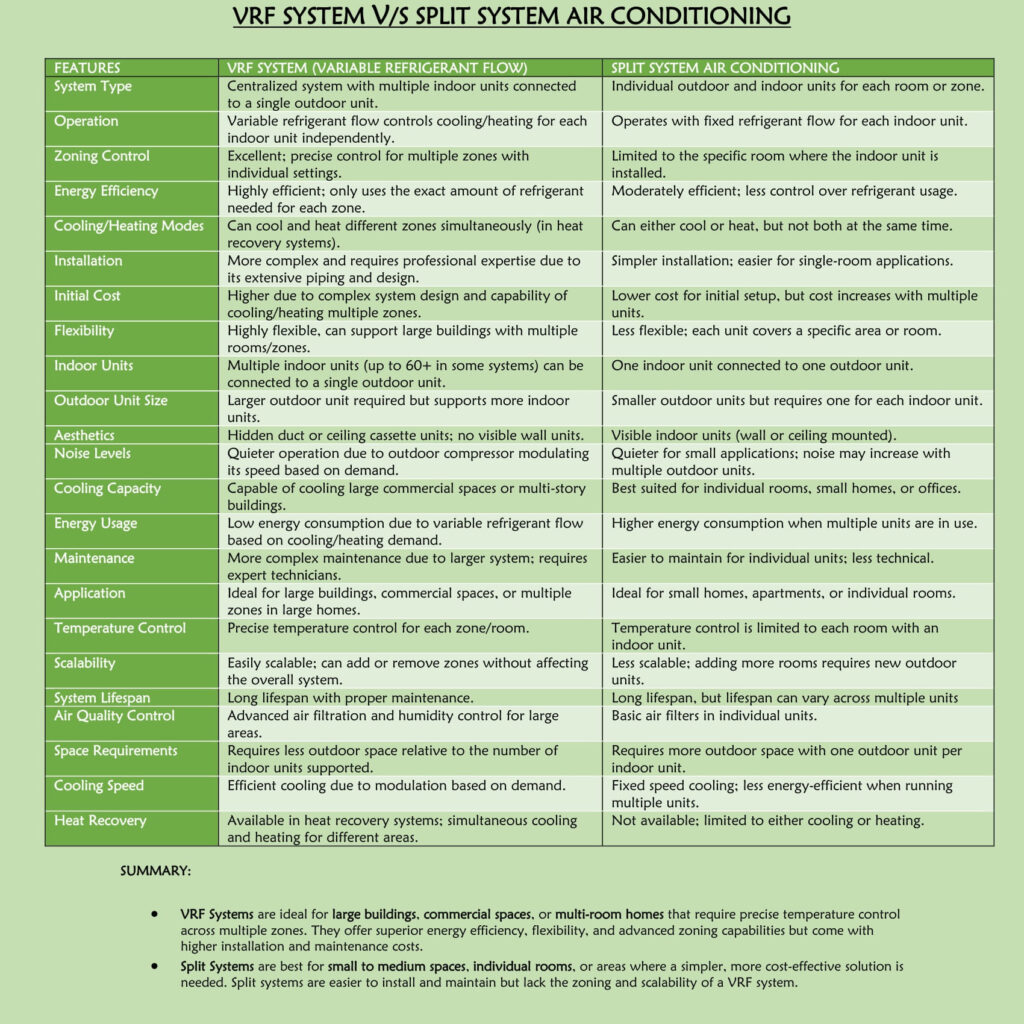
VRF SYSTEM V/S SPLIT SYSTEM AIR CONDITIONING:
| FEATURES | VRF SYSTEM (VARIABLE REFRIGERANT FLOW) | SPLIT SYSTEM AIR CONDITIONING |
| System Type | Centralized system with multiple indoor units connected to a single outdoor unit. | Individual outdoor and indoor units for each room or zone. |
| Operation | Variable refrigerant flow controls cooling/heating for each indoor unit independently. | Operates with fixed refrigerant flow for each indoor unit. |
| Zoning Control | Excellent; precise control for multiple zones with individual settings. | Limited to the specific room where the indoor unit is installed. |
| Energy Efficiency | Highly efficient; only uses the exact amount of refrigerant needed for each zone. | Moderately efficient; less control over refrigerant usage. |
| Cooling/Heating Modes | Can cool and heat different zones simultaneously (in heat recovery systems). | Can either cool or heat, but not both at the same time. |
| Installation | More complex and requires professional expertise due to its extensive piping and design. | Simpler installation; easier for single-room applications. |
| Initial Cost | Higher due to complex system design and capability of cooling/heating multiple zones. | Lower cost for initial setup, but cost increases with multiple units. |
| Flexibility | Highly flexible, can support large buildings with multiple rooms/zones. | Less flexible; each unit covers a specific area or room. |
| Indoor Units | Multiple indoor units (up to 60+ in some systems) can be connected to a single outdoor unit. | One indoor unit connected to one outdoor unit. |
| Outdoor Unit Size | Larger outdoor unit required but supports more indoor units. | Smaller outdoor units but requires one for each indoor unit. |
| Aesthetics | Hidden duct or ceiling cassette units; no visible wall units. | Visible indoor units (wall or ceiling mounted). |
| Noise Levels | Quieter operation due to outdoor compressor modulating its speed based on demand. | Quieter for small applications; noise may increase with multiple outdoor units. |
| Cooling Capacity | Capable of cooling large commercial spaces or multi-story buildings. | Best suited for individual rooms, small homes, or offices. |
| Energy Usage | Low energy consumption due to variable refrigerant flow based on cooling/heating demand. | Higher energy consumption when multiple units are in use. |
| Maintenance | More complex maintenance due to larger system; requires expert technicians. | Easier to maintain for individual units; less technical. |
| Application | Ideal for large buildings, commercial spaces, or multiple zones in large homes. | Ideal for small homes, apartments, or individual rooms. |
| Temperature Control | Precise temperature control for each zone/room. | Temperature control is limited to each room with an indoor unit. |
| Scalability | Easily scalable; can add or remove zones without affecting the overall system. | Less scalable; adding more rooms requires new outdoor units. |
| System Lifespan | Long lifespan with proper maintenance. | Long lifespan, but lifespan can vary across multiple units |
| Air Quality Control | Advanced air filtration and humidity control for large areas. | Basic air filters in individual units. |
| Space Requirements | Requires less outdoor space relative to the number of indoor units supported. | Requires more outdoor space with one outdoor unit per indoor unit. |
| Cooling Speed | Efficient cooling due to modulation based on demand. | Fixed speed cooling; less energy-efficient when running multiple units. |
| Heat Recovery | Available in heat recovery systems; simultaneous cooling and heating for different areas. | Not available; limited to either cooling or heating. |
SUMMARY:
- VRF Systems are ideal for large buildings, commercial spaces, or multi-room homes that require precise temperature control across multiple zones. They offer superior energy efficiency, flexibility, and advanced zoning capabilities but come with higher installation and maintenance costs.
- Split Systems are best for small to medium spaces, individual rooms, or areas where a simpler, more cost-effective solution is needed. Split systems are easier to install and maintain but lack the zoning and scalability of a VRF system.
